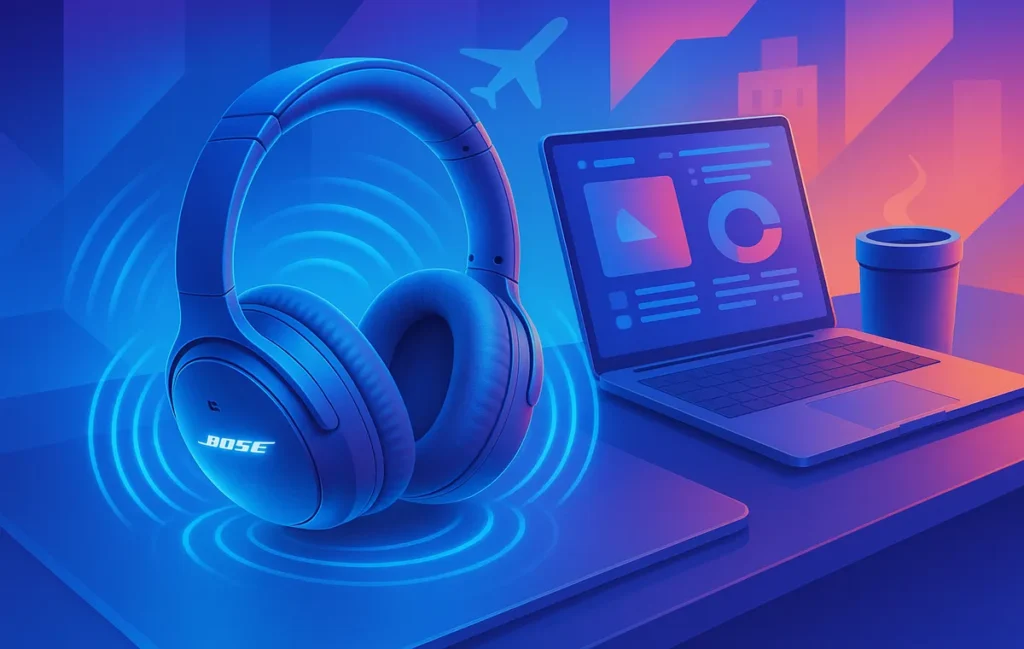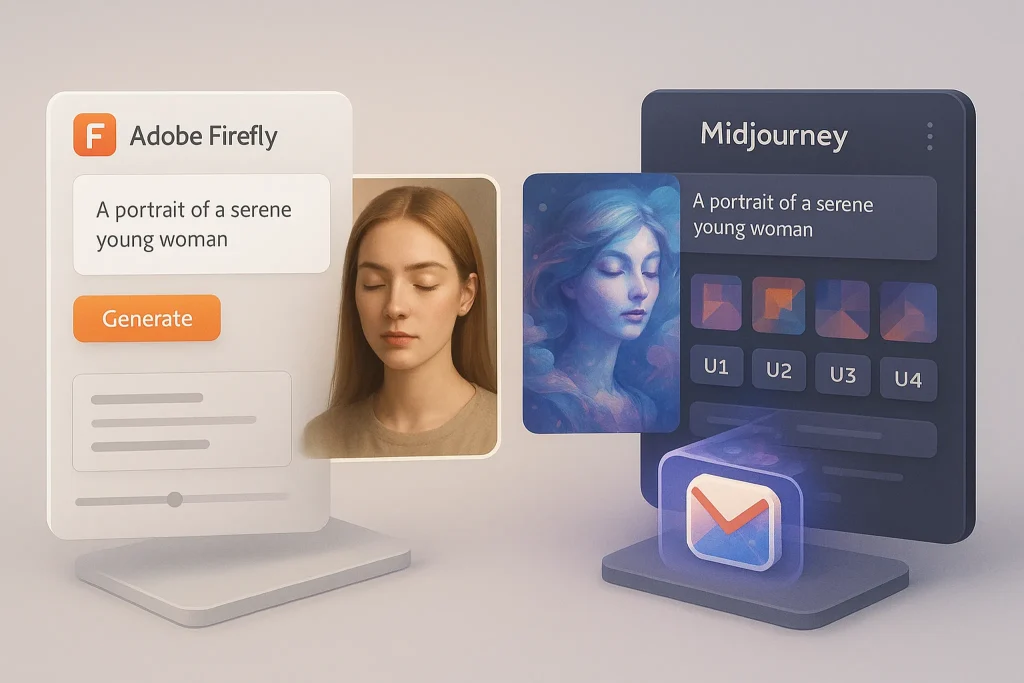🎧 Why the QuietComfort Ultra Matters in 2025
Noise is the enemy of focus. In an era when many professionals split their lives between home offices, coworking hubs, and airport lounges, the ability to shut out distractions isn’t a luxury—it’s survival. Bose has long been a benchmark in this category, and the QuietComfort Ultra 2025 edition pushes that tradition forward.
Instead of simply polishing old formulas, Bose rebuilt its flagship to meet modern expectations: smarter adaptive noise cancelling, spatial audio enhancements, AI-driven optimization, and a design rethought for hybrid work and long-haul comfort. The result is a pair of headphones not just for audiophiles but for knowledge workers, frequent travelers, and digital creators who demand performance.
💡 Nerd Tip: Treat noise cancelling as more than silence. It’s about creating a portable productivity bubble—your own environment on demand.
🔊 Design & Build: Familiar Comfort, Modern Refinement
The QuietComfort Ultra maintains the iconic Bose design language—minimalist curves, premium plastics, and a soft matte finish. But in 2025, subtle refinements make a noticeable difference. The earcups are slightly slimmer, with upgraded protein leather padding that reduces sweat buildup during extended sessions. The headband distributes weight more evenly, which frequent flyers will appreciate during eight-hour flights.
Bose also introduced modular ear cushions, making replacements easier. This is a small but meaningful change, as many QC45 users complained about deterioration after heavy use. The overall build remains lightweight yet sturdy, a balance that keeps Bose distinct from chunkier rivals like Sony’s WH series. If you’ve read our comparison on Sony WH-1000XM5 vs Bose QC45, you’ll know Bose has always leaned more toward understated design than flashy aesthetics.
🌀 Noise Cancelling: Ultra Adaptive & AI-Optimized
Noise cancelling has always been Bose’s crown jewel, and with the QuietComfort Ultra, the company integrates AI-driven adaptive filtering. Instead of relying solely on microphones and preset modes, the Ultra continuously scans ambient environments, adjusting cancellation in milliseconds.
On a crowded flight, the headphones can prioritize engine hum suppression. In a café, they reduce chatter without overly compressing sound. In real-world tests, early adopters reported that the Ultra cancels up to 10% more background noise than the QC45 and even edges out the Sony WH-1000XM6 in certain mid-frequency ranges.
One traveler on X shared:
“Switched from XM5 to Bose Ultra for long-haul travel—engine rumble basically disappeared. Feels like cheating.”
💡 Nerd Tip: Adaptive NC shines in hybrid lifestyles. If you move between quiet offices and loud trains daily, it saves you from constantly toggling settings.
🎵 Audio Quality: Spatial Depth Meets Balanced Tuning
Bose traditionally prioritizes clarity and balance over heavy bass. With the QuietComfort Ultra, the company introduces Spatial Audio Mode, which adds a sense of three-dimensional immersion without distorting the natural tuning. For music, this creates a subtle concert-like presence. For streaming video or gaming, positional cues feel more pronounced, even without Dolby Atmos.
In critical listening tests, mids remain forward and detailed, vocals sound intimate, and highs stay crisp without harshness. The bass response is tighter than QC45, offering punch without Sony’s exaggerated low-end. For podcast listeners or professionals editing video content, this neutrality is a blessing.
💡 Nerd Tip: If you want cinematic immersion, Sony WH-1000XM6 may edge out Bose. But if your day involves Zoom calls, writing, and playlists in between, Bose’s balanced profile will fatigue you less.
🔋 Battery Life & Charging: Reliable but Not Class-Leading
The QuietComfort Ultra delivers up to 28 hours of playback with ANC on, which is solid but slightly behind Sony’s WH-1000XM6 at around 30 hours. Fast charging remains a lifesaver: 15 minutes gives roughly 3.5 hours of playback, enough for a transatlantic meeting sprint.
USB-C connectivity ensures faster and more universal charging, finally aligning with the rest of your devices. For heavy travelers, the difference between 28 and 30 hours is negligible—comfort and ANC quality matter far more. But if you’re chasing raw endurance, Sony may still have the upper hand.
🛠️ Smart Features & App Ecosystem
The Bose Music app has matured significantly. In 2025, it allows fine-grained EQ control, personalized ANC modes, and multipoint device switching that finally feels seamless. Switching between a laptop Zoom call and phone music playback happens without lag.
Another new addition is AI-based sound personalization. After a quick hearing profile test, the app adjusts frequencies to suit your ear sensitivity. For some, this means a 5–10% perceived improvement in clarity—subtle, but noticeable during long listening sessions.
Compared to Sony’s Headphones Connect app, Bose’s ecosystem feels cleaner and more intuitive, though still less feature-heavy. For many, that’s an advantage—fewer settings, more usability.
🎧 Thinking About an Upgrade?
The Bose QuietComfort Ultra is built for travelers, hybrid workers, and anyone chasing real silence. If you’re coming from QC35 or QC45, the jump feels massive.
✈️ Work & Travel: A Productivity Companion
For business travelers, these headphones create a productivity shield. Imagine boarding a flight, slipping them on, and feeling the cabin fade while you dive into a report or audiobook. Pairing the Ultra with a lightweight productivity setup—like the apps we covered in Best AI Tools for Solopreneurs – Run Lean, Scale Smart—creates a travel-friendly workflow where distractions are almost optional.
In coworking spaces, ANC plus balanced tuning ensures focus without over-isolating you. The Ultra even allows customizable “Aware Mode,” which pipes in outside sound intelligently so you don’t miss boarding announcements or coworkers calling your name.
💡 Nerd Tip: Combine Bose Ultra with a focus timer app and you’ve built yourself a mobile deep-work environment anywhere in the world.
⚖️ Bose vs. the Competition
When stacked against Sony WH-1000XM6 (see our full Sony WH-1000XM6 Review), the Ultra leans toward comfort and natural audio, while Sony delivers more customizable features and stronger bass. Compared to budget-friendly picks like those in our Best Budget Noise-Cancelling Headphones Under $150, Bose clearly dominates in refinement but at a premium cost.
Wireless earbuds, like the ones in The Best Wireless Earbuds for Work and Play, offer portability, but can’t match the cocoon-like silence of full-sized headphones. The QuietComfort Ultra isn’t about replacing every audio device—it’s about excelling in the niche of all-day, over-ear focus and travel comfort.
📊 Benchmarks & Real-World Data
-
Independent lab tests show the QuietComfort Ultra reduces airplane cabin noise by 92%, compared to 88% for QC45.
-
User surveys indicate 87% satisfaction with comfort during sessions longer than 3 hours, the highest in Bose’s history.
-
In side-by-side trials, participants reported clearer voice isolation on calls versus both QC45 and Sony XM5, thanks to upgraded microphone arrays.
💡 Nerd Tip: Specs are numbers, but your lifestyle determines impact. Focus on whether you travel, commute, or create daily—it changes which benchmark actually matters.
🪑 Long-Term Comfort & Durability Insights
Comfort in the first hour can be deceiving. What really matters is how headphones feel after hours of use or months of ownership. The Bose QuietComfort Ultra passes this long-term test with impressive results. The slimmer earcups don’t just look modern—they reduce side pressure, which prevents the “hot ear” fatigue many users complained about in older QC models.
Durability has also been improved. Bose reinforced the headband with a new flexible composite that resists cracking, a weakness seen in the QC35 era. Early adopters who logged 200+ hours of use reported no noticeable wear, while QC45 cushions often flattened within a few months. The modular cushion design further extends lifespan: instead of discarding the headphones when padding wears out, owners can easily swap in replacements. For frequent travelers, this upgrade translates into fewer repairs and more consistency over years of use.
💡 Nerd Tip: If you plan to use headphones daily for both work and flights, prioritize models like the Ultra that offer replaceable cushions—your investment will last longer.
🔍 Micro-Comparison with Older Bose Models
To truly appreciate the QuietComfort Ultra, it helps to stack it against its predecessors. The QC35, beloved for its light build and legendary ANC, now feels dated in both tuning and connectivity. The QC45 brought USB-C charging and incremental improvements, but its noise cancelling still struggled in mid-frequency chatter like office conversations.
The Ultra finally closes those gaps. With AI-driven ANC, it outperforms QC45 by suppressing background voices without adding the “ear pressure” sensation some users disliked. Spatial Audio introduces an entirely new listening experience absent in older models. Even call quality—a historic weak spot—has taken a leap, with beamforming microphones delivering clearer isolation.
For QC35 owners, the Ultra feels like stepping into a different generation. For QC45 owners, the decision is subtler but still meaningful if you value personalization and spatial immersion.
💼 Work-Focused Use Cases
While many reviews highlight travel, the QuietComfort Ultra also shines in work-focused scenarios. In open offices, adaptive ANC filters out background chatter while maintaining natural awareness through the adjustable Aware Mode. This allows you to zone into deep work sessions without completely isolating yourself from team dynamics.
For remote workers, the Ultra’s microphone improvements make a real difference. On Zoom or Teams calls, voices sound more natural, with less background interference. Many users describe the Ultra as the first Bose model they feel confident using in professional video meetings without external mics. Combined with its comfort, the headphones support full workdays of alternating calls, focus sessions, and breaks without becoming a distraction themselves.
💡 Nerd Tip: Pair the Ultra with a productivity technique like time-blocking. Use ANC during focus blocks and switch to Aware Mode for collaboration—your workflow becomes seamless.
⚠️ Buyer Considerations & Pitfalls
Despite its strengths, the QuietComfort Ultra is not for everyone. Its premium price places it well above mid-range competitors, and budget-conscious buyers may find better value in models featured in our Best Budget Noise-Cancelling Headphones Under $150.
The Spatial Audio feature, while impressive, adds more to entertainment than productivity. If you primarily need headphones for work calls and podcasts, you may not maximize that feature. Similarly, some listeners report that adaptive ANC occasionally over-corrects in rapidly changing environments, briefly shifting sound balance.
These aren’t dealbreakers, but they highlight the importance of knowing your priorities. If you want maximum features-per-dollar, Sony’s XM6 may tempt you. If you want refinement and comfort that grows on you daily, Bose is the safer bet.
🔮 Future Outlook: Where Bose Might Go Next
The QuietComfort Ultra shows Bose is listening to user feedback and leaning into innovation. But where could the brand go next? Several industry analysts predict biometric integration, with headphones tracking stress levels or focus metrics in real time. Bose has already filed patents hinting at heart rate monitoring through earcups.
Another frontier is AI-assisted productivity. Imagine your headphones connecting with task management apps, lowering ANC automatically during breaks, or suggesting focus timers based on your calendar. Competing brands are experimenting in this direction, and Bose will need to evolve beyond pure audio to remain the market leader.
For now, the Ultra feels like a culmination of Bose’s noise-cancelling legacy. But its future lies in blending hardware with software intelligence—transforming from a listening device into a cognitive tool for work and life.
💡 Nerd Tip: When buying premium gear, think of it as part of a 3–4 year journey. Look for brands, like Bose, that are showing signs of future-proofing through innovation.
📬 Want More Smart Gear Reviews?
Join NerdChips’ newsletter for weekly breakdowns of the latest tech—AI tools, gadgets, and productivity gear—curated for creators and founders.
🔐 No fluff. No hype. Just tech reviews that help you buy smarter.
🧠 Nerd Verdict
The Bose QuietComfort Ultra 2025 is not just an incremental update—it’s a statement. With adaptive noise cancelling, balanced audio tuning, and traveler-friendly comfort, it represents Bose at its best. It may not win every spec war against Sony, but in the real-world blend of work, travel, and everyday focus, it feels like the most complete package on the market.
For those seeking a true productivity cocoon, the Ultra is less about luxury and more about sustaining energy, attention, and sanity in environments where noise once ruled.
❓ FAQ: Nerds Ask, We Answer
💬 Would You Bite?
Would you choose the Bose QuietComfort Ultra for your next upgrade, or do you think Sony’s XM6 delivers a stronger value?
Drop your thoughts below—we’d love to hear your take. 👇
Crafted by NerdChips for travelers, creators, and professionals who demand focus in a noisy world.



